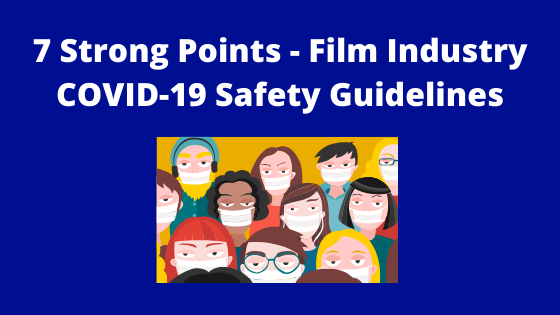7 Strong Points – Film Industry COVID-19 Safety Guidelines

Share this
The Industry-Wide Labor-Management Safety Committee Task Force has released their film industry safety guidelines for resuming production. California Governor Gavin Newsom signed off on these safety protocols, allowing filming in the state to start again on June 12th. IATSE Local 600, the International Cinematographers Guild, also released their own set of Recommended Departmental Protocols. Both sets of guidelines are detailed and cover all aspects of production. However, the AMPTP is still in negotiations with the various unions to finalize an agreement before pre-production can start this summer.
As film production takes place in many locations outside California and New York, it is uncertain at this point if all the recommended safety procedures will be universally followed. Will these union recommendations be adhered to by non-union crews in other states? Will the same strict safety protocols be practiced for a small crew on set for a one day commercial shoot as for a feature film or TV series?
Here are 7 of the key safety recommendations in the reports:
- Autonomous COVID-19 Compliance Officers with specialized training to be present in the workplace. On large features and TV shows, their presence is a given. It’s essential to have someone with specialized knowledge and training responsible for safety on set in the middle of a pandemic. It remains to be seen whether these compliance officers will also be present on small commercial or industrial shoots.
- Prioritize filming locations where the location can be secured and the cast and crew can be kept away from the general public. This would eliminate a lot of locations from consideration. Commercials I’ve worked on for Lowe’s, Walmart, Ace Hardware and Conn’s Furniture all come to mind. All the stores were open when we filmed in them, with customers nearby. I’m not sure this recommendation can or will be followed, especially for commercials, unless locations are willing to shut down entirely to accommodate a filming.
- Limit the duration of work days and excessive consecutive work days to ensure cast and crew get adequate rest. This has been an ongoing issue in the film industry for many years, although it isn’t as big an issue on a short one or two day shoot as it is on longer productions. Lack of sleep and excessive work harms the immune system, which is especially dangerous during a pandemic. Allowing enough time for realistic shooting schedules to facilitate the amount of work that needs to be done could save lives. Maybe COVID-19 will be the tipping point for this ongoing safety issue in our industry.
- The convivial atmosphere at lunch won’t be the same. Staggered lunch times, social distancing and no buffet will be the new dining reality when these recommendations go into effect. Individually packaged meals and snacks are suggested. Another recommendation is that cast and crew not leave the work site to get food during the workday, which means the company would have to provide lunch both on stage and on location.
- Masks and other PPE provided on set by the employer. As masks and social distancing are considered crucial safety recommendations, I would expect to see these on both large and small productions. In fact, I’ll be asking about it on any calls I get for work. The COVID-19 numbers are still going up in many places, so if a company isn’t even willing to provide masks, you can bet there are other important safety protocols they’re ignoring.
- The Local 600 camera crew guidelines recommend only one member of the camera crew at a time to work on the truck and physical indicators placed inside all equipment trucks to mark 6 feet for social distancing.
- The Local 600 recommendations also state that no one should have to waive their rights or assume liability to go back to work. I believe this refers to the health liability waivers that cast and crew members may be asked to sign. The DGA has already advised their members not to sign any health liability waiver without sending it to the Guild first for review. It’s unclear at this point whether health liability waivers will be a requirement with one standard document approved for all productions or not. I expect we’ll be hearing a lot more about these waivers in the near future.
Another thought I had is about the many commercials I’ve worked on that were DGA, but the rest of the cast and crew is non-union. Will the set safety protocols be different than if the show is entirely non-union? Will non-union shows also abide by the final film industry safety protocols negotiated by the AMPTP and the unions? Hopefully, we'll have the answers to those questions in the near future. We need to return to work safely.